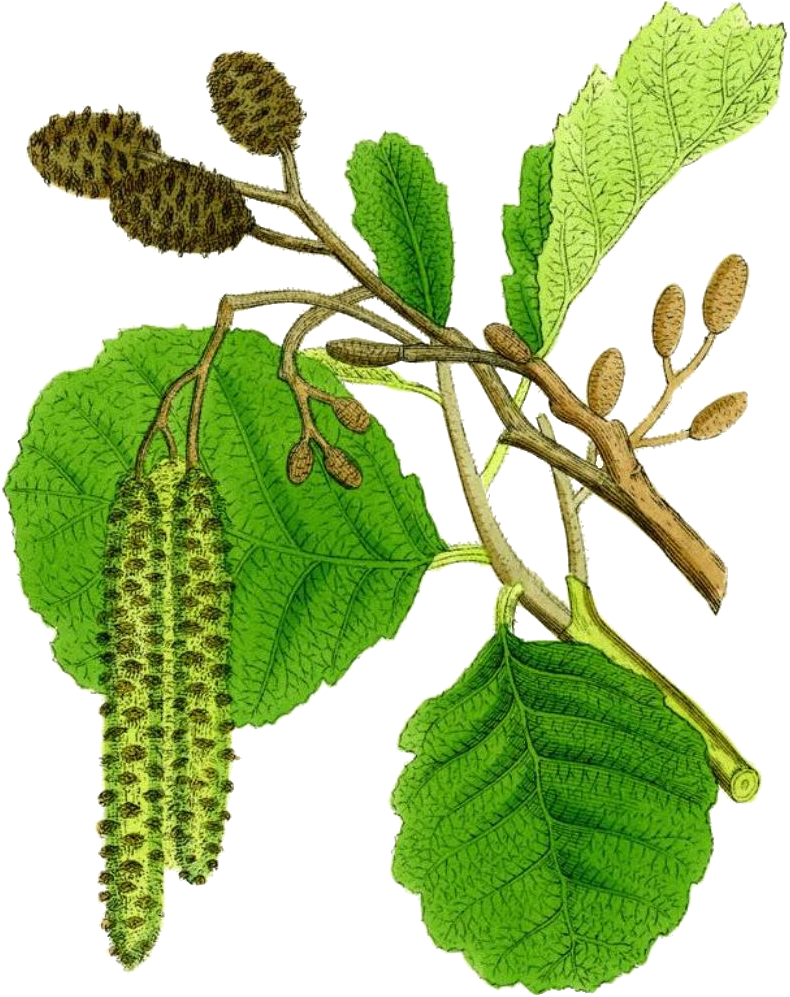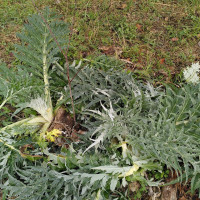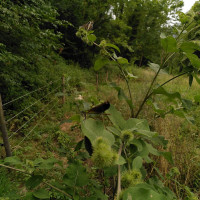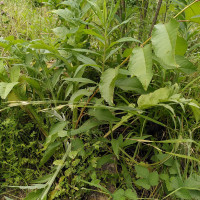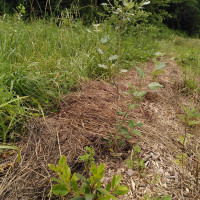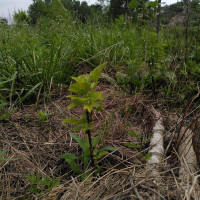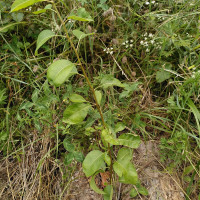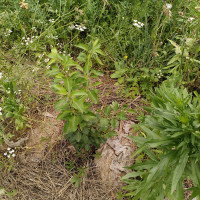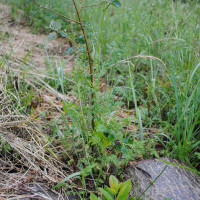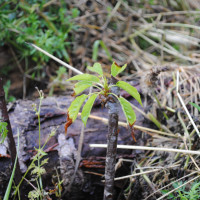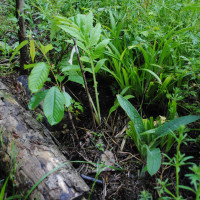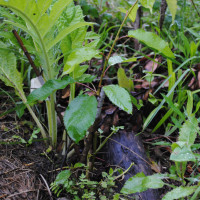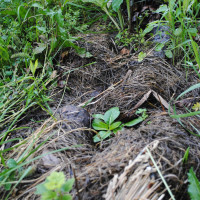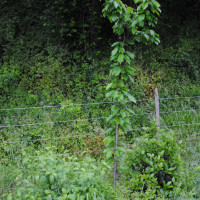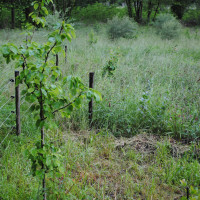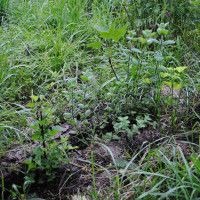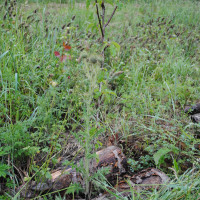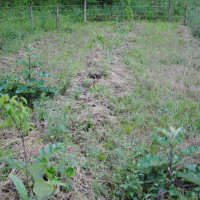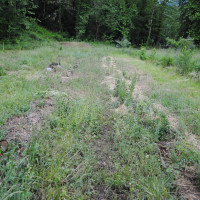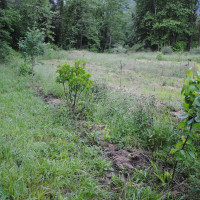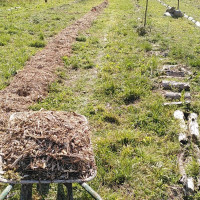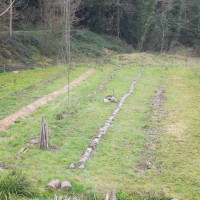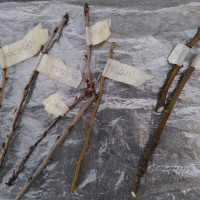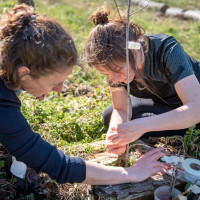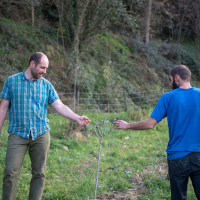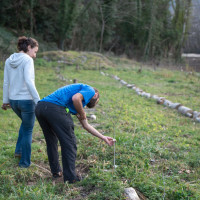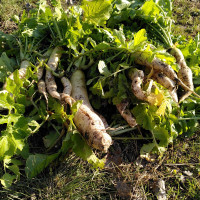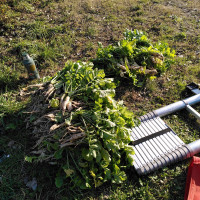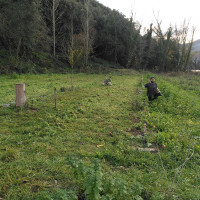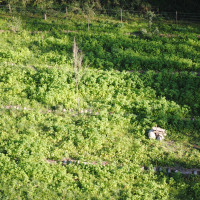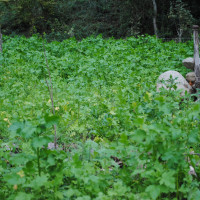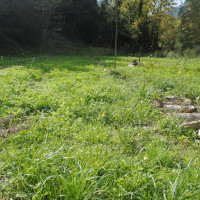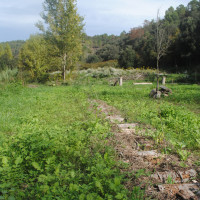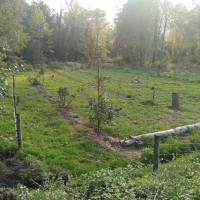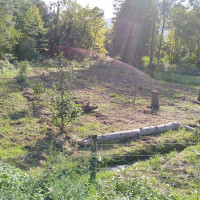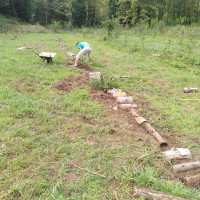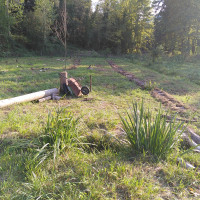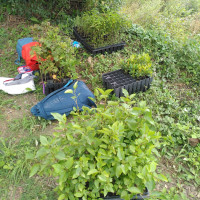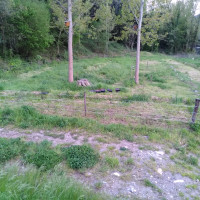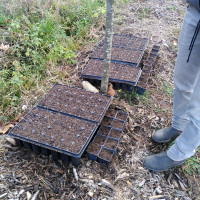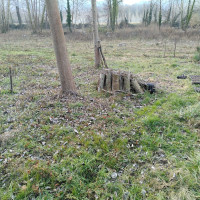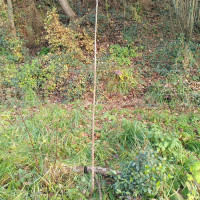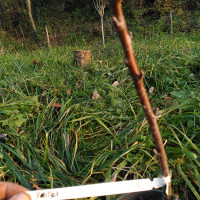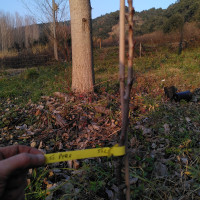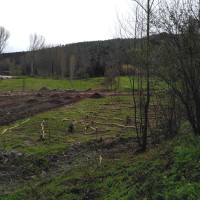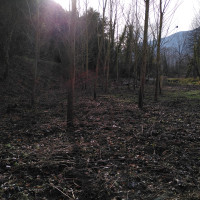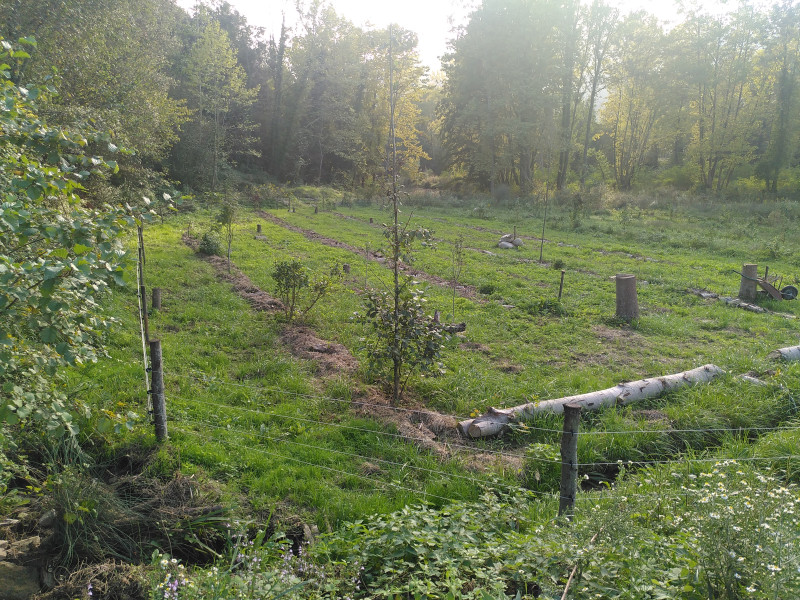Syntropic 2: Native bushes
Using pioneer speecies to create a dense plantation of native bushes and trees.
Native crops are Prunus avium, Pyrus communis, Arbutus unedo, Corylus avellana and Amelanchier ovalis. Additional rootstocks may be grafted: Crataeagus monogyna (C. azarolus) and Cornus mas (multiple varieties).
Canopy rows
| Species variety | Var | Leafing | Flowering | Fruiting | ||||||||||||||||||||||||||||||||||||
|---|---|---|---|---|---|---|---|---|---|---|---|---|---|---|---|---|---|---|---|---|---|---|---|---|---|---|---|---|---|---|---|---|---|---|---|---|---|---|---|---|
Populus nigra |
|
|
| |||||||||||||||||||||||||||||||||||||
Prunus avium Bigarreau burlat | Bigarreau burlat Fruto de tamaño grande, piel de color rojo oscuro y brillante. Pulpa firme, crujiente, azucarada y jugosa. Excelente variedad para el consumo en fresco. Variedad temprana, maduración entre finales de mayo y principios de junio. Sin duda en Francia es la variedad más extendida de las Bigarreau. (Src:Arboreco) |
|
|
| ||||||||||||||||||||||||||||||||||||
Prunus avium Ferrovia | Ferrovia Frutos muy gruesos un poco puntiagudas, rojo brillante. Pulpa crujiente, dulce y jugosa. Pedúnculo largo. Variedad de referencia entre la mayoría de las pantas. Maduración a mediados de Junio. (Src:apicepiante.eu) |
|
|
| ||||||||||||||||||||||||||||||||||||
Prunus avium San pedro | San pedro Fruto de calibre entre mediano y pequeño, de forma alargada, pedúnculo muy largo, piel de color rojo-amarillento en una cara y la otra amarilla. Pulpa consistente y por lo tanto, aparte de un consumo en fresco, se presta para la preparación de licores. Se cosecha a mediados de Junio (Begues – Barcelona). Árbol de medio vigor, hoja con limbo muy serrado, característico de las cerezas conocidas como fuertes. (Src:Arboreco) |
|
|
| ||||||||||||||||||||||||||||||||||||
Prunus cerasus Bigarreau geant d’hedelfingen | Bigarreau geant d’hedelfingen Fruto de calibre grueso con piel de coloración roja brillante que se vuelve púrpura cuando madura. Pulpa firme, jugosa y perfumada. Se recoge a finales de junio. Variedad muy productiva y de floración tardía. Se considera una de las mejores variedades polinizadoras. (Src:Arboreco) |
|
|
| ||||||||||||||||||||||||||||||||||||
Pyrus communis Castells – pera de san juan | Castells – pera de san juan Fruto de tamaño pequeño bastante aplastado, pedúnculo fino y carnoso en la base. Piel verdosa, verde-amarilla y amarillo limón cuando es madura. Presenta una mancha roja rosada en la cara donde le toca el sol. Carne blanca, firme y azucarada de un sabor característico que hace que se la considere una pera veraniega de calidad. El primer lugar donde apareció fue en Can Castells de Sant Boi de Llobregat, procedente de Sur América, el 1850. Árbol muy vigoroso, porte erecto y con pocas ramificaciones. Fructifica básicamente en lamburdas que se tienen que respetar durante la poda. Es muy productiva cuando se consigue equilibrarla. Variedad autoestéril, favorece la polinización de Ercolini, Blanquilla, Moscatella, Cañella y Campmanya. Se recoge los últimos diez días de junio. (Src:Arboreco) |
|
|
| ||||||||||||||||||||||||||||||||||||
Pyrus communis Ercolini | Ercolini Fruto medio, alargado, cónico, piel fina, lisa, de color verde claro-amarillenta que tiende a amarillo intenso hacia la maduración con mancha rojiza en el lado soleado. Pulpa blanco-crema, fondant, jugosa, azucarada, sabor delicioso y ligeramente perfumada. Fruto resistente a las manipulaciones post-cosecha. Maduración entre finales de julio y principios de agosto. Variedad toscana (Italia), árbol vigoroso y productivo, muy fértil sobre todo si es injertado sobre membrillero, floración medio-precoz y se puede adaptar bien a zonas cálidas. Actualmente variedad con un gran potencial comercial. (Src:Arboreco) |
|
|
| ||||||||||||||||||||||||||||||||||||
Pyrus communis Limonera | Limonera Fruto de calibre grande de forma piriforme. Piel de color verde amarillento con punteado y un poco de carmín en la parte soleada. Pulpa blanca, un poco granulosa, azucarada, ligeramente perfumada y de sabor muy agradable. Se recoge hacia la tercera semana de julio. Variedad obtenida por M. Baltet, horticultor de Trayes (Francia) en el 1870. Árbol muy rústico y de rápida entrada en producción, indicada para zonas con inviernos largos y frío. (Src:Arboreco) |
|
|
| ||||||||||||||||||||||||||||||||||||
Sorbus aria |
|
|
| |||||||||||||||||||||||||||||||||||||
Sorbus domestica |
|
|
| |||||||||||||||||||||||||||||||||||||
Sorbus torminalis |
|
|
| |||||||||||||||||||||||||||||||||||||
Cornus mas |
|
|
| |||||||||||||||||||||||||||||||||||||
Cynara cardunculus |
|
|
| |||||||||||||||||||||||||||||||||||||
Cynara scolymus |
|
|
| |||||||||||||||||||||||||||||||||||||
Ribes rubrum Junifer | Junifer a grosella Junifer é unha variedade precoz que produce froitos dende principios de xullo. É unha variedade moi vigorosa e moi productiva con froitos de cor vermello brillante. Planta bastante rústica, de exposición sol ou semisombra. (Src: Fragaira) Leaves before Rovada (RVS, home nursery from cuttings) |
|
|
| ||||||||||||||||||||||||||||||||||||
Ribes rubrum Rovada | Rovada heavy-cropping, late summer-ripening redcurrant cultivar, producing long strings of larger fruit making it easy to harvest (Src:rhs) Noted for its excellent fruit quality and high yields, Ribes rubrum 'Rovada' is a compact, deciduous shrub boasting clusters of pale green flowers in spring. They are followed by a bountiful crop of long, drooping clusters of large, edible, bright red currants which ripen in late summer. Juicy, the fruits can be eaten fresh from the shrub or can be used in sophisticated foods, drinks and desserts. The erect canes are clothed in mid-green, 3-5 lobed leaves which are aromatic when crushed. This plant is self-fertile and resistant to leafspot. (Src:gardenia.net) |
|
|
| ||||||||||||||||||||||||||||||||||||
Sambucus nigra |
|
|
|
| Species variety | Tip | Qty | Introduction | Phase-out | Propagation | Medium | Supplier |
|---|---|---|---|---|---|---|---|
Populus nigra | Populus and Salix cutting propogation: Las estacas de Populus y Salix hay que prepararlas cuando no tienen hojas, a sabia parada. Igualmente, el brote que te puedan hacer ahora no estará lignificado y con el frío del invierno se puede quemar. Estas estacas enraizaran y brotaran en primavera, por lo que en invierno poco van a hacer. [Plant supplier / nursery] Q__ La estaca de Populus/Salix, tiene que ser del año de crecimiento o puede ser de 2/3 años? Puede ser de 2/3 años. A__ Nosotros lo hacemos en alveolo forestal, por lo que utilizamos estacas delgadas, del año, pero en campo es conveniente ponerlas más gordas para que tengan más reservas y aguanten el terreno. Q__ Y se puede enterrar/clavar la estaca muy profundo, como 40-50cm o más? Se puede pudrir? A__Sí, se puede pudrir, sobretodo si hay agua estancada durante muchos días. Yo intentaría clavarlas en febrero para que estén el menor tiempo enterradas y sin brotar. [Plant supplier / nursery][naturalea.eu] Poplar's high water content can cause Frost crack when too cold. Can hybrid poplars have less or more resistance? Thorny branches can help protect seedlings from boars or deer. Having a diversity of support species can reduce the animal's focus on the cash crop. Trees with fibrous root structures (poplars, acacias, oaks) are able to improve soil though growth and dieback every year, not the case with every species. Is this related to the tree being deciduous or its ability to re-grow after pruning? [youtu.be] Cuttings directly on the ground need a wide area clearing and weed suppression, use large leaves and heavy thick mulch. [Can Neret] Deer likes young poplar leaves. Use very long cuttings to reduce risk. [Can Neret] Hybrid poplars grow much, much faster without weed competition. Plantings are made on bare ground and disced 4 times a year on the first year for this reason. Management is no longer required when undergrowth is shaded after 2nd year. [lignovis.com] | 25 | 2022-09-28 | Stem cutting | Tray | Forestal Catalana | |
Prunus avium Bigarreau burlat | Fruit trees in hot climate benefit from having a little bit of shade. [youtu.be] "increased firmness in sweet cherry can also be accomplished by the use of gibberellin (GA3), which growers apply during fruit development" p.86 [Growing Fruit Trees: Novel Concepts and Practices for Successful Care and Management, Lespinasse & Leterme] | 2 | 2021-03-11 | Graft | Bare-root | Arboreco | |
Prunus avium Ferrovia | Fruit trees in hot climate benefit from having a little bit of shade. [youtu.be] "increased firmness in sweet cherry can also be accomplished by the use of gibberellin (GA3), which growers apply during fruit development" p.86 [Growing Fruit Trees: Novel Concepts and Practices for Successful Care and Management, Lespinasse & Leterme] | 3 | 2021-03-11 | Graft | Bare-root | Arboreco | |
Prunus avium San pedro | Fruit trees in hot climate benefit from having a little bit of shade. [youtu.be] "increased firmness in sweet cherry can also be accomplished by the use of gibberellin (GA3), which growers apply during fruit development" p.86 [Growing Fruit Trees: Novel Concepts and Practices for Successful Care and Management, Lespinasse & Leterme] | 2 | 2021-03-11 | Graft | Bare-root | Arboreco | |
Prunus cerasus Bigarreau geant d’hedelfingen | "increased firmness in sweet cherry can also be accomplished by the use of gibberellin (GA3), which growers apply during fruit development" p.86 [Growing Fruit Trees: Novel Concepts and Practices for Successful Care and Management, Lespinasse & Leterme] | 5 | 2021-03-11 | Graft | Bare-root | Arboreco | |
Pyrus communis Castells – pera de san juan | 2 | 2021-03-11 | Graft | Bare-root | Arboreco | ||
Pyrus communis Ercolini | 3 | 2021-03-11 | Graft | Bare-root | Arboreco | ||
Pyrus communis Limonera | 2 | 2022-03-06 | Graft | Container | |||
Sorbus aria | 2 | 2022-02-16 | Seed | Container | Forestal Catalana | ||
Sorbus domestica | 2 | 2021-03-11 | Seed | Container | Jardineria Kuka | ||
Sorbus torminalis | Before the introduction of hops, the fruit were used to flavour beer. [wikipedia.org] | 2 | 2022-09-14 | Seed | Container | Forestal Catalana | |
Cornus mas | Cornus Mas grafting: Svitlana Klymenko noted that the developed technology of vegetative reproduction allows to obtain high-quality planting material. Budding is the most efficient method for dogwood. Acceptance of meshes in nurseries is 90-95%, through lay-ups - 80-90%, and herbaceous cuttings - 75-78%. [Plant supplier / nursery] Low nitrogen demand. [Edible Forest Gardens Vol.2] I keep all cornus up to maximum 2 meters high. So they have stronger roots and small crone and than they have bigger fruit. [Plant supplier / nursery] | 25 | 2022-09-14 | Seed | Tray | Carex Vivers | |
Cynara cardunculus | 25 | 2023-03-12 | Seed | Seed | Cantueso | ||
Cynara scolymus | 25 | 2023-03-12 | Seed | Seed | Cantueso | ||
Ribes rubrum Junifer | Shrubs benefit from proximity for cross pollination. In shade: taller, thinner, leggier. In sun: denser, smaller [Edible Forest Gardens Vol.2] No grass near the roots. Shoots should not be older than 4 years for black currants, 5 years for other currants. Prune after harvesting. Need more than one variety for good pollination. Estacas de Ribes: Normalmente se entierra la mitad de la vara como máximo, 15- 20 cm. es suficiente en todo caso. Los primeros 20 cm. del suelo son los más fértiles normalmente. Lo que enraíza primero es la punta. Si se entierra demasiado es más probable que se infecte por patógenos. [Plant supplier / nursery] Ribes nigrum cuttings were collected November 9th. Planted on the 12th/nov. They had roots late December. [Can Neret] Cuttings directly on the ground need a wide area clearing and weed suppression, use large leaves and heavy thick mulch. [Can Neret] | 10 | 2023-03-12 | Stem cutting | Cutting | Fragaira | |
Ribes rubrum Rovada | Shrubs benefit from proximity for cross pollination. In shade: taller, thinner, leggier. In sun: denser, smaller [Edible Forest Gardens Vol.2] No grass near the roots. Shoots should not be older than 4 years for black currants, 5 years for other currants. Prune after harvesting. Need more than one variety for good pollination. Estacas de Ribes: Normalmente se entierra la mitad de la vara como máximo, 15- 20 cm. es suficiente en todo caso. Los primeros 20 cm. del suelo son los más fértiles normalmente. Lo que enraíza primero es la punta. Si se entierra demasiado es más probable que se infecte por patógenos. [Plant supplier / nursery] Ribes nigrum cuttings were collected November 9th. Planted on the 12th/nov. They had roots late December. [Can Neret] Cuttings directly on the ground need a wide area clearing and weed suppression, use large leaves and heavy thick mulch. [Can Neret] | 10 | 2023-03-12 | Stem cutting | Cutting | Fragaira | |
Sambucus nigra | Elderberry cuttings take months to root. Had more success with propagation at end of summer, after the first rains wet the ground and the parent plant are hydrated. [Can Neret] |
| Species variety | Fnc | Strata | Top | Cut months | Light | Functions | |
|---|---|---|---|---|---|---|---|
Populus nigra | Emergent | 4m | Pollard | ~50% | Pioneering, Crop shading | ||
Prunus avium Bigarreau burlat | Canopy | 3m | Prune | ~50% | |||
Prunus avium Ferrovia | Canopy | 3m | Prune | ~50% | |||
Prunus avium San pedro | Canopy | 3m | Prune | ~50% | |||
Prunus cerasus Bigarreau geant d’hedelfingen | Canopy | 3m | Prune | ||||
Pyrus communis Castells – pera de san juan | Canopy | 3m | Prune | ||||
Pyrus communis Ercolini | Canopy | 3m | Prune | ||||
Pyrus communis Limonera | Canopy | 3m | Prune | ||||
Sorbus aria | Canopy | 3m | Prune | ||||
Sorbus domestica | Canopy | 3m | Prune | ||||
Sorbus torminalis | Canopy | 3m | Prune | ||||
Cornus mas | Understory | 2m | Prune | ~50% | Rootstock for grafting | ||
Cynara cardunculus | Undergrowth | 1m | Coppice | Pioneering | |||
Cynara scolymus | Undergrowth | 1m | Coppice | Pioneering | |||
Ribes rubrum Junifer | Undergrowth | 1.5m | Prune | ||||
Ribes rubrum Rovada | Undergrowth | 1.5m | Prune | ||||
Sambucus nigra | Undergrowth | 1m | Coppice | ~50% | Pioneering |
Understory rows
| Species variety | Var | Leafing | Flowering | Fruiting | ||||||||||||||||||||||||||||||||||||
|---|---|---|---|---|---|---|---|---|---|---|---|---|---|---|---|---|---|---|---|---|---|---|---|---|---|---|---|---|---|---|---|---|---|---|---|---|---|---|---|---|
Populus alba |
|
|
| |||||||||||||||||||||||||||||||||||||
Amelanchier ovalis |
|
|
| |||||||||||||||||||||||||||||||||||||
Arbutus unedo |
|
|
| |||||||||||||||||||||||||||||||||||||
Arbutus unedo Atlantic | Atlantic short internodes and more compact development, which makes more fruits than the type. (~2x1.5m) |
|
|
| ||||||||||||||||||||||||||||||||||||
Corylus avellana |
|
|
| |||||||||||||||||||||||||||||||||||||
Crataegus azarolus |
|
|
| |||||||||||||||||||||||||||||||||||||
Crataegus monogyna |
|
|
|
| Species variety | Tip | Qty | Introduction | Phase-out | Propagation | Medium | Supplier |
|---|---|---|---|---|---|---|---|
Populus alba | Populus and Salix cutting propogation: Las estacas de Populus y Salix hay que prepararlas cuando no tienen hojas, a sabia parada. Igualmente, el brote que te puedan hacer ahora no estará lignificado y con el frío del invierno se puede quemar. Estas estacas enraizaran y brotaran en primavera, por lo que en invierno poco van a hacer. [Plant supplier / nursery] Q__ La estaca de Populus/Salix, tiene que ser del año de crecimiento o puede ser de 2/3 años? Puede ser de 2/3 años. A__ Nosotros lo hacemos en alveolo forestal, por lo que utilizamos estacas delgadas, del año, pero en campo es conveniente ponerlas más gordas para que tengan más reservas y aguanten el terreno. Q__ Y se puede enterrar/clavar la estaca muy profundo, como 40-50cm o más? Se puede pudrir? A__Sí, se puede pudrir, sobretodo si hay agua estancada durante muchos días. Yo intentaría clavarlas en febrero para que estén el menor tiempo enterradas y sin brotar. [Plant supplier / nursery][naturalea.eu] Poplar's high water content can cause Frost crack when too cold. Can hybrid poplars have less or more resistance? Trees with fibrous root structures (poplars, acacias, oaks) are able to improve soil though growth and dieback every year, not the case with every species. Is this related to the tree being deciduous or its ability to re-grow after pruning? [youtu.be] Cuttings directly on the ground need a wide area clearing and weed suppression, use large leaves and heavy thick mulch. [Can Neret] Deer likes young poplar leaves. Use very long cuttings to reduce risk. [Can Neret] | 25 | 2022-09-28 | Stem cutting | Tray | Forestal Catalana | |
Amelanchier ovalis | Edible fruit - raw or cooked. Not very palatable, but it can be used for preserves etc. The fruit is rich in iron and copper. [pfaf.org] | 25 | 2022-09-14 | Seed | Tray | Forestal Catalana | |
Arbutus unedo | Low N demand, sun, slow growing, form/partner with Ectomycorrhizal - Inoculate from wild.
Sensitive to transplanting. [Edible Forest Gardens Vol.2] Low nitrogen demand. [Edible Forest Gardens Vol.2] | 25 | 2022-09-14 | Seed | Tray | Forestal Catalana | |
Arbutus unedo Atlantic | Low N demand, sun, slow growing, form/partner with Ectomycorrhizal - Inoculate from wild.
Sensitive to transplanting. [Edible Forest Gardens Vol.2] Low nitrogen demand. [Edible Forest Gardens Vol.2] | 1 | 2023-11-13 | Stem cutting | Container | Lurberry | |
Corylus avellana | Fruit trees in hot climate benefit from having a little bit of shade. [youtu.be] Hazelnut propagation best layered (not grafted). This allows to cut old, unproductive stems and have new suckers with the same genetic stock. [youtu.be] When pruning large branches, cut top half first to reduce weight. With less pressure cutting at the base, diagonally, becomes easier. [Can Neret] Manure + crop harvest can result in E. coli. This applies especially if harvesting crop on the ground, but hand harvesting also requires hygiene. | 25 | 2022-09-14 | Seed | Tray | Forestal Catalana | |
Crataegus azarolus | 2 | 2022-09-14 | Graft | Container | Jardineria Kuka | ||
Crataegus monogyna | 25 | 2022-09-14 | Seed | Tray | Forestal Catalana |
| Species variety | Fnc | Strata | Top | Cut months | Light | Functions | |
|---|---|---|---|---|---|---|---|
Populus alba | Emergent | 4m | Pollard | ~50% | Pioneering, Crop shading | ||
Amelanchier ovalis | Understory | 2m | Prune | ||||
Arbutus unedo | Understory | 2m | Prune | >75% | |||
Arbutus unedo Atlantic | Understory | 9m | >75% | ||||
Corylus avellana | Understory | 2m | Prune | ~50% | |||
Crataegus azarolus | Stock for grafting. | Understory | 2m | Prune | ~50% | ||
Crataegus monogyna | Understory | 2m | Prune | Rootstock for grafting |
Project Log
2024 week 10 17/2°C, 5.5mm
2024 week 09 17/3°C, 33.3mm
2024 week 08 18/3°C, 3.3mm
2024 week 07 20/4°C, 0mm
2024 week 06 18/5°C, 18.5mm
Cynara scolymus managed on foot of plum tree
2023 week 26 34/18°C, 0.1mm
2023 week 25 31/17°C, 26mm
2023 week 24 31/16°C, 8.6mm
2023 week 23 28/14°C, 5.5mm
2023 week 22 26/12°C, 17.8mm
Before summer drought. Ribes did not survive. Butterflly and dragonfly on burdock (Arctium sp., an indicator of high nitrogen in soil).
2023 week 19 23/11°C, 55mm
2023 week 18 26/9°C, 16.1mm
2023 week 17 25/11°C, 10.2mm
2023 week 16 23/6°C, 6.8mm
2023 week 15 22/5°C, 0.9mm
5/5 cherry grafts successful with chip budding. 1/2 pears succesful. Populus alba by Arbutus unedo growing, and Cynara spp. by grafted cherries.
2023 week 09 12/-1°C, 0mm
2023 week 08 16/4°C, 27.5mm
2023 week 07 18/-0°C, 0.2mm
2023 week 06 11/0°C, 43.4mm
2023 week 05 19/-2°C, 0mm
Poplar and acacia woodchip distributing. Seeded ground cover Medicago sativa, Festuca arundinacea, Phacelia tanacetifolia
2023 week 07 17/-1°C, 0.2mm
2023 week 06 11/0°C, 43.4mm
2023 week 05 19/-2°C, 0mm
2023 week 04 10/-4°C, 3.1mm
2023 week 03 12/-1°C, 0.1mm
Grafting cherry and pear. Scions were collected 2023-02-05 and kept in the fridge in sealed bag.
2022 week 50 14/5°C, 12.4mm
2022 week 49 15/4°C, 2mm
2022 week 48 14/1°C, 2mm
2022 week 47 17/4°C, 23.5mm
2022 week 46 19/8°C, 13.9mm
Harvest radish before wild boars, shred and organize ground cover.
2022 week 46 22/11°C, 0mm
2022 week 45 23/8°C, 2.2mm
2022 week 44 23/7°C, 2mm
2022 week 43 26/10°C, 0.1mm
2022 week 42 27/13°C, 0.1mm
Aerial view
2022 week 43 28/11°C, 0mm
2022 week 42 27/13°C, 0.1mm
2022 week 41 26/12°C, 0.2mm
2022 week 40 24/12°C, 42.7mm
2022 week 39 25/10°C, 13.9mm
Ground cover growth, 5 weeks after seeding
2022 week 41 26/12°C, 0.2mm
2022 week 40 24/12°C, 42.7mm
2022 week 39 25/10°C, 13.9mm
2022 week 38 26/13°C, 15.7mm
2022 week 37 30/16°C, 20.6mm
3 weeks after seeding ground cover.
2022 week 38 26/13°C, 15.6mm
2022 week 37 30/16°C, 20.6mm
2022 week 36 31/17°C, 0.1mm
2022 week 35 32/18°C, 14.2mm
2022 week 34 33/19°C, 20.3mm
Seed inter-row with Alfalfa, Spelt, and abono verde: (20% de Trebol Rojo, 20% habin forrajero, 20 % Veza Sativa, 20% Mostaza forrajera, 20% Rábano forrajero.)
2022 week 37 30/16°C, 20.6mm
2022 week 36 31/17°C, 0.1mm
2022 week 35 32/18°C, 14.2mm
2022 week 34 33/19°C, 20.3mm
2022 week 33 31/17°C, 52.2mm
Beginning conversion to Syntropic plantation.
2022 week 37 32/17°C, 0.6mm
2022 week 36 31/17°C, 0.1mm
2022 week 35 32/18°C, 14.2mm
2022 week 34 33/19°C, 20.3mm
2022 week 33 31/17°C, 52.2mm
Time for redesign. Understory plants arrived: Corylus avellana, Arbutus unedo, Crataegus monogyna*, Amelanchier ovalis and Cornus mas* (*for grafting).
2022 week 15 21/8°C, 5.6mm
2022 week 14 20/4°C, 12.6mm
2022 week 13 15/4°C, 24.4mm
2022 week 12 16/5°C, 15.2mm
2022 week 11 14/9°C, 34.7mm
Shredding. There was little rain after and no growth prior to the sumer heat. The area dried-up, some tree seedlings were lost.
2022 week 01 15/-1°C, 2.9mm
2022 week 52 14/1°C, 0.4mm
2021 week 52 20/7°C, 0mm
2021 week 51 16/2°C, 0.4mm
2021 week 50 16/-1°C, 0.4mm
Using sandy soil on seed trays was heavy to carry and had poor moisture retention. Trays were left too exposed, seeds dried mid-winter. No germination.
2021 week 51 14/-0°C, 0.1mm
2021 week 50 16/-1°C, 0.4mm
2021 week 49 14/1°C, 0mm
2021 week 48 14/0°C, 0.5mm
2021 week 47 12/4°C, 62.4mm
Planting cherry tree varieties
2021 week 10 16/4°C, 8.1mm
2021 week 09 15/6°C, 7.9mm
2021 week 08 18/6°C, 11.6mm
2021 week 07 16/6°C, 3mm
2021 week 06 14/4°C, 13.7mm
Poplar chopping
Lessons
- Can Neret
[Reap/mow] When mowing the inter-rows or cover crop, make sure there is enough rain forecast for it to re-grow before summer drought. Having a low or no cover will increase the soil temperature and cause water loss affecting all plants in the area.(Dactylis glomerata ,Festuca arundinacea ,Medicago sativa) - "increased firmness in sweet cherry can also be accomplished by the use of gibberellin (GA3), which growers apply during fruit development" p.86Growing Fruit Trees: Novel Concepts and Practices for Successful Care and Management, Lespinasse & Leterme
(Prunus avium ,Prunus cerasus) - Can Neret
[Design /Seed] When mixing seeds, understand the cycle of each species. Src: Seeded spelt with winter-only cover. Lost spelt on managed cutting 12 weeks later.(Triticum spelta)
